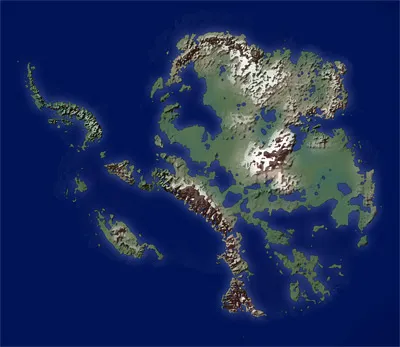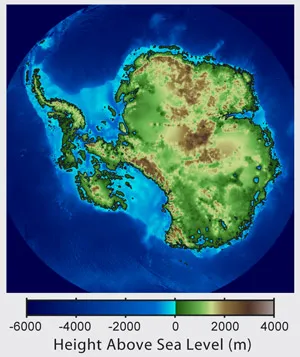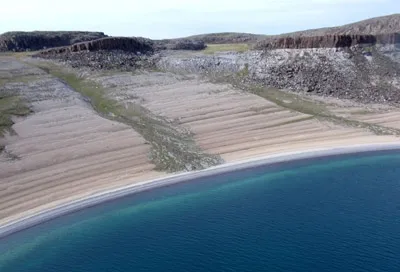What if all the ice melted in Antarctica?
Antarctica What Ifs ? - Almost definitely won't-happens, but what if some unlikely things did theoretically happen in Antarctica?
What if all the ice melted? | What if we had to move there? | What if Antarctica was green? | What if Antarctica was a country?1 - How Much Ice is There ?
Antarctica has about 25,400,000 cubic kilometers of ice (6,090,000 cubic miles). This is 60% of all the freshwater and 90% of all the ice on earth.

The bedrock of Antarctica under the ice, green to brown areas are above sea level, blue to purple are below
2 - Sea Level Changes
If all the Antarctic ice melted it would raise the average sea level by about 70 m (230 feet) worldwide. This would change the map of the world as we know it as all coastlines would flood including the loss of all coastal cities in the world. Florida would disappear entirely along with most of Denmark, the Netherlands, Bangladesh, and many small island nations, some lower lying countries such as the UK and Uruguay would lose a significant proportion of their land area. Australia would gain a large inland sea. River estuaries would become much larger and they and the paths of their rivers would expand significantly inland drowning floodplains and many riverbank communities.
Billions of people, up to 40% of the world population would be displaced and have to move to higher ground.
Currently 98% of Antarctica is covered in permanent ice the now exposed Antarctica would reveal itself not as a single landmass but as a collection of islands some of which would be very large. If Antarctic ice melted, then Arctic ice would melt too exposing Greenland in a similar way as the current 80% ice cover disappeared compensating somewhat for the loss of land elsewhere.
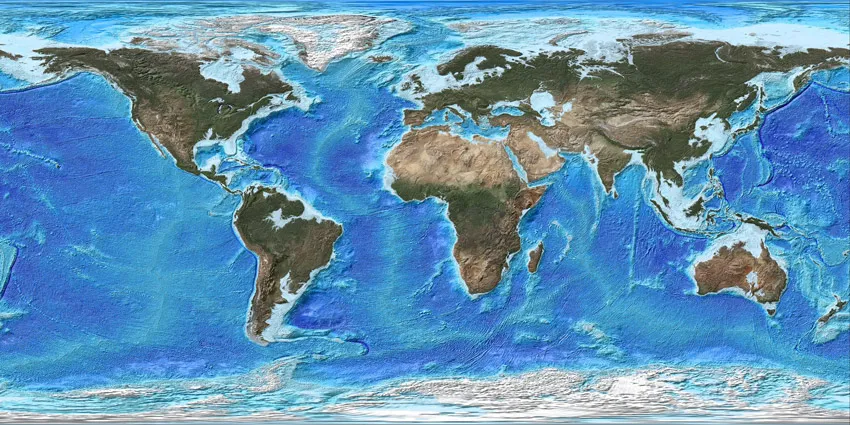
A world map after a 70m sea level
rise.
3 - Sea Chemistry Changes
All of that melted ice is freshwater and not sea-ice meaning that it would dilute the worlds oceans making them less salty, but not just that, it would have an effect on other dissolved chemicals and the pH or acidity of the sea water. While these effects might be quite small, in the region of 2% on average, they will have an effect on some sensitive living creatures in the oceans and also on oceanic currents which in part are driven by changes in salinity as well as temperature. These would have very significant climatic effects of their own.
The effect of ice melting on ocean chemistry would be very significant as it was melting and much more so than when mixed. The flood of freshwater extending north from Antarctica would have very large local effects. The extent of these local effects would depend on the rate of the melting and amount of mixing. Slow release over a long time period reduces the effect.

The thermohaline circulation that
distributes heat around the planet in the deep oceans, it is
driven by salinity and temperature differences in the water,
any change in either can upset the circulation, it takes about
2,000 years for a complete circuit.
4 - Isostatic Rebound
The earth consists of a patchwork of solid rock tectonic plates between about 50 and 200km thick floating on liquid rock beneath. Antarctica is currently like a heavily laden ship in the water due to the weight of all that ice on top of it. If the ice was removed the Antarctic plate would start to rise, a process known as isostatic rebound, just like taking heavy cargo off a ship. Of course we are talking about massive slabs of rock and magma here, so this rebound is extremely slow, it would take tens of thousands of years to rise to a new equilibrium level. We know this because there are places in the Arctic, especially Northern Canada and Scandinavia that are still rebounding back 10,000 years after the last ice age pushed their rocks into the magma.
This rebound is estimated to happen at the rate of about 7.5cm per year for the first 2,000 years, then slowing to 2.5cm per year decreasing to 1cm per year for the next 10,000 with the whole process taking around 20,000 years. The uplift is not uniform and can reach up to 400m.
5 - Other Temperature Effects
If we are considering a situation where all of the ice in Antarctica has melted, then it would mean that temperatures had risen way beyond any of the most extreme scenarios of climate change. The tropics would become uninhabitable for people as would some of the currently most populated parts of the world forcing everyone closer towards the poles and towards livable climates.
Crops would fail and ecosystems would be devastated, depending on the speed of the melting it would be a huge extinction event for all kinds of animal and plant species, a real apocalyptic scenario.
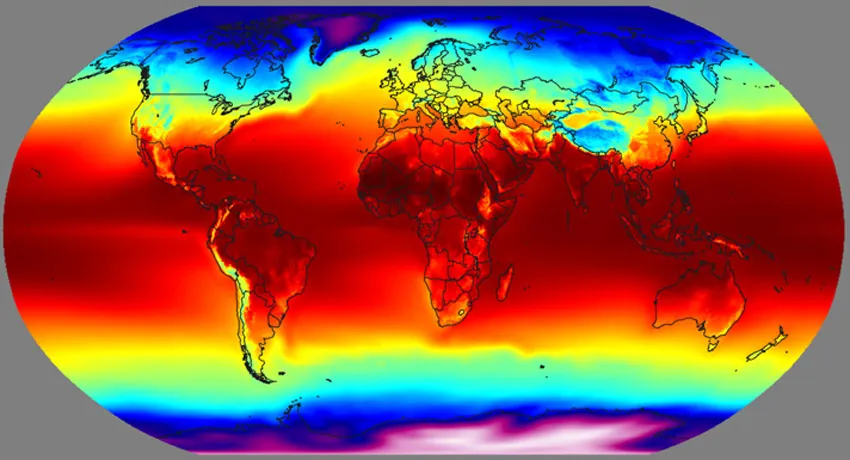
6 - The Last Time There Was no Antarctic Ice
The fossil record shows that the Antarctic ice sheet began to form about 35 million years ago (MYA), global temperatures were on average about 4C higher than they are today. One of the reasons for this was the isolation of Antarctica becoming positioned over the South Pole and the development of the Circumpolar Current due to South America drifting away and leaving a gap for the current to flow through. Antarctica became ever colder as it was isolated from weather systems in the rest of the world.
The land mass of Antarctica had been ice free for a long time, during the late cretaceous period about 90 million years ago it was covered with a swampy temperate rainforest similar to those found in New Zealand today, this was during the warmest period in the last 140 million years. Large parts of this forest would have been in darkness for many weeks or several months in the polar night. Carbon dioxide levels at that time were around 1,120-1,680 parts per million (ppm), they are currently (2024) at 424 ppm and rising at about 2 ppm per year.
7 - Possible Large Scale Melting Events
There is a possibility that the Thwaites Glacier (picture at top of page) in Western Antarctica may collapse in the next several decades, this would add around 65cm (2 feet) to global sea-levels, this is not a certainty and the situation is being closely monitored both to find out what this glacier is doing and also for what we can learn about glacier and ice sheet collapse that could be applied elsewhere.
The West Antarctic Ice Sheet (WAIS) of which the Thwaites is part could also potentially collapse though over a longer time period and what will happen may not be clear until 2100 or later, this would raise global sea-levels by around 4m (13 feet).
8 - What are the Chances of All the Ice Melting in Antarctica ?
About zero, for the next several hundred years at least. The good news is that it's not going to happen any time soon even in the most extreme and unlikely predictions.
Picture credits: Antarctica under the ice - Paul V. Heinrich, used under Creative Commons Attribution Share Alike licence 3.0 Unported licence / Antarctica ice removed - Memtgs, used under Creative Commons Attribution licence 3.0 Unported licence / World map - Kevin Gill, used under Creative Commons Attribution 2.0 Generic (CC BY 2.0) licence, from Flickr / Thermohaline - BlankMap-World6.svg, used under Creative Commons Attribution Share Alike licence 3.0 Unported licence / Isostatic rebound and Earth extreme temperatures, Robert A. Rohde - Global Warming Art used under Creative Commons Attribution Share Alike licence 3.0 Unported licence. / Foss a siou, JD554, used under Creative Commons Attribution Share Alike licence 3.0 Unported licence.

